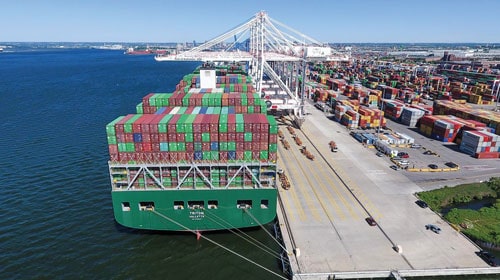By the BF Staff
From the September/October 2020 Issue
Increases in cargo volumes and new and returning business from national retailers helped the Helen Delich Bentley Port of Baltimore surge to significantly higher month-over-month numbers in July, signaling a continued rebound from the impact of the COVID-19 emergency. New figures for July show the Port’s state-owned, public marine terminals saw double-digit increases compared to the previous month for autos/light trucks, roll on/roll off farm and construction equipment, containers and general cargo.

“The positive trends we’re seeing at the Port of Baltimore give us confidence that Maryland’s economy is recovering in a big way,” said Governor Larry Hogan. “We’re seeing new records for container moves and noteworthy cargo increases—all strong signs of consumer confidence.”
While down compared to last year, cargo counts have grown steadily in recent months. In July, key categories at the Port’s public marine terminals saw increases compared to June:
- Autos/Light Trucks (units) +55.4 percent
- General Cargo (tons) +15.0 percent
- Roll on/Roll Off (tons) +13.5 percent
- Containers (boxes) +11.7 percent
“The Port has been a critical link in the supply chain throughout the COVID-19 emergency, and we know it will play a huge role in Maryland’s recovery,” said Transportation Secretary Greg Slater. “The ability to handle this surge is a testament to our dedicated team at the Port and the strength of our infrastructure.”
The port has seen increases in recent months, including: Grocery chain ALDI continues to increase its shipping through the port, projecting about 5,000 containers annually; pharmacy chain Rite Aid is bringing new business to the port, projecting about 700 containers for the second half of 2020; Big Lots began its initial shipments through the Port of Baltimore this month.
In another positive indicator, imported autos/light trucks unloaded from ships at the Port are heading straight to dealerships, instead of waiting days at the Port for pickup. Recently, Volkswagen began importing autos at Tradepoint Atlantic’s Sparrows Point facility. Ports America Chesapeake, which operates the Port’s Seagirt Marine Terminal, serves as stevedore for Volkswagen vehicle operations.
“We are seeing cargo volumes improving month over month in most sectors, including huge upticks in automobiles,” said Maryland Department of Transportation Maryland Port Administration (MDOT MPA) Executive Director William P. Doyle. “We have also attracted new business, which has increased the volume of dry and refrigerated containers being carried on Neo-Panamax vessels calling on the Port of Baltimore. These are all great economic indicators, though we must recognize this still remains an unpredictable maritime trade environment.”
The positive July results follow a new record set at the Port when 5,536 container moves were conducted by longshore workers handling the Maersk Edinburgh over three days. It was the largest number of moves for a single ship in the Port’s 314-year history. This successful container movement is clearly gaining attention attracting two new businesses, Rite Aid and Big Lots, and one returning business, Levin Furniture, that chose the Port of Baltimore to deliver their products efficiently to their customers.
The Port of Baltimore continues to receive supersize ships that can only visit ports with the infrastructure necessary to accommodate them, including Maersk Line’s Maersk Edinburgh vessel, which has a capacity of 13,092 TEU containers, Evergreen’s Triton (14,424 TEU capacity) and Mediterranean Shipping Co.’s Maria Elena (9,200 TEU capacity).
Want to learn more about Maryland?
Considering Maryland for your company’s relocation or expansion project? Check out all the latest news related to Maryland economic development, corporate relocation, corporate expansion and site selection.
















![[VIDEO] Get More for Your Business in Ardmore. Oklahoma](https://businessfacilities.com/wp-content/uploads/2024/02/maxresdefault-324x160.jpg)
